washer fluid CHEVROLET SUBURBAN 1994 Owners Manual
[x] Cancel search | Manufacturer: CHEVROLET, Model Year: 1994, Model line: SUBURBAN, Model: CHEVROLET SUBURBAN 1994Pages: 385, PDF Size: 19.88 MB
Page 96 of 385
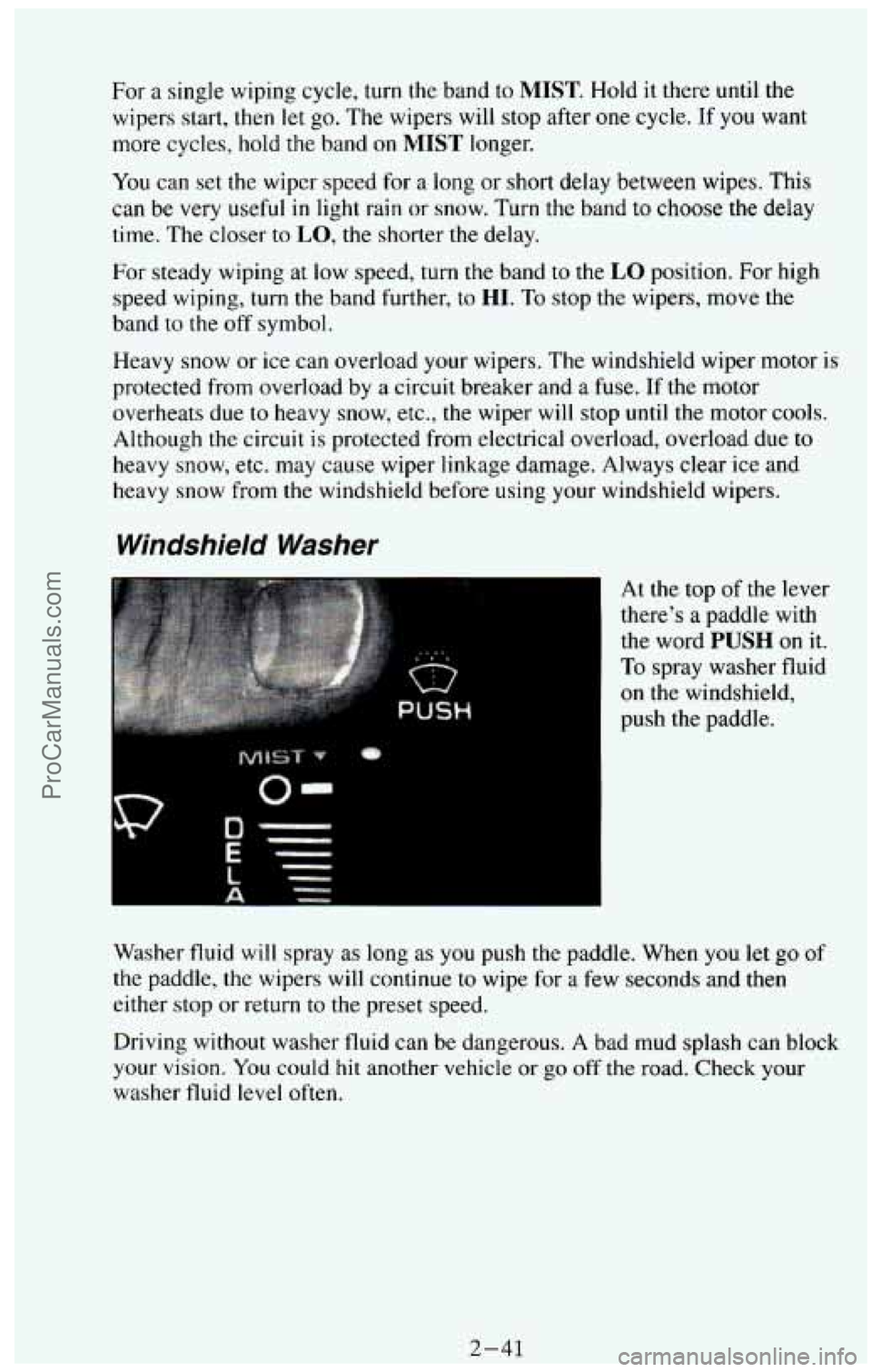
For a single wiping cycle, turn the band to MIST. Hold it there until the
wipers start, then let go.
The wipers will stop after one cycle. If you want
more cycles, hold
the band on MIST longer.
You can set the wiper speed for a long or short delay between wipes. This
can be very
useful in light rain or snow. Turn the band to choose the delay
time.
The closer to LO, the shorter the delay.
For steady wiping at low speed, turn the band to the LO position. For high
speed wiping, turn the band further, to
HI. To stop the wipers, move the
band to the off symbol.
Heavy snow or ice can overload your wipers.
The windshield wiper motor is
protected from overload by a circuit breaker and a
fuse. If the motor
overheats due to
heavy snow, etc., the wiper will stop until the motor cools.
Although
the circuit is protected from electrical overload, overload due to
heavy snow, etc. may cause wiper linkage damage. Always clear ice and
heavy snow from
the windshield before using your windshield wipers.
Windshield Washer
0-
At the top of the lever
there's
a paddle with
the word
PUSH on it.
To spray washer fluid
on the windshield,
push the paddle.
Washer fluid will spray as long
as you push the paddle. When you let go of
the paddle, the wipers will continue to wipe for a few seconds and then
either stop or return
to the preset speed.
Driving without washer fluid can be dangerous. A bad mud splash can block
your vision.
You could hit another vehicle or go off the road. Check your
washer fluid level often.
2-41 ProCarManuals.com
Page 97 of 385
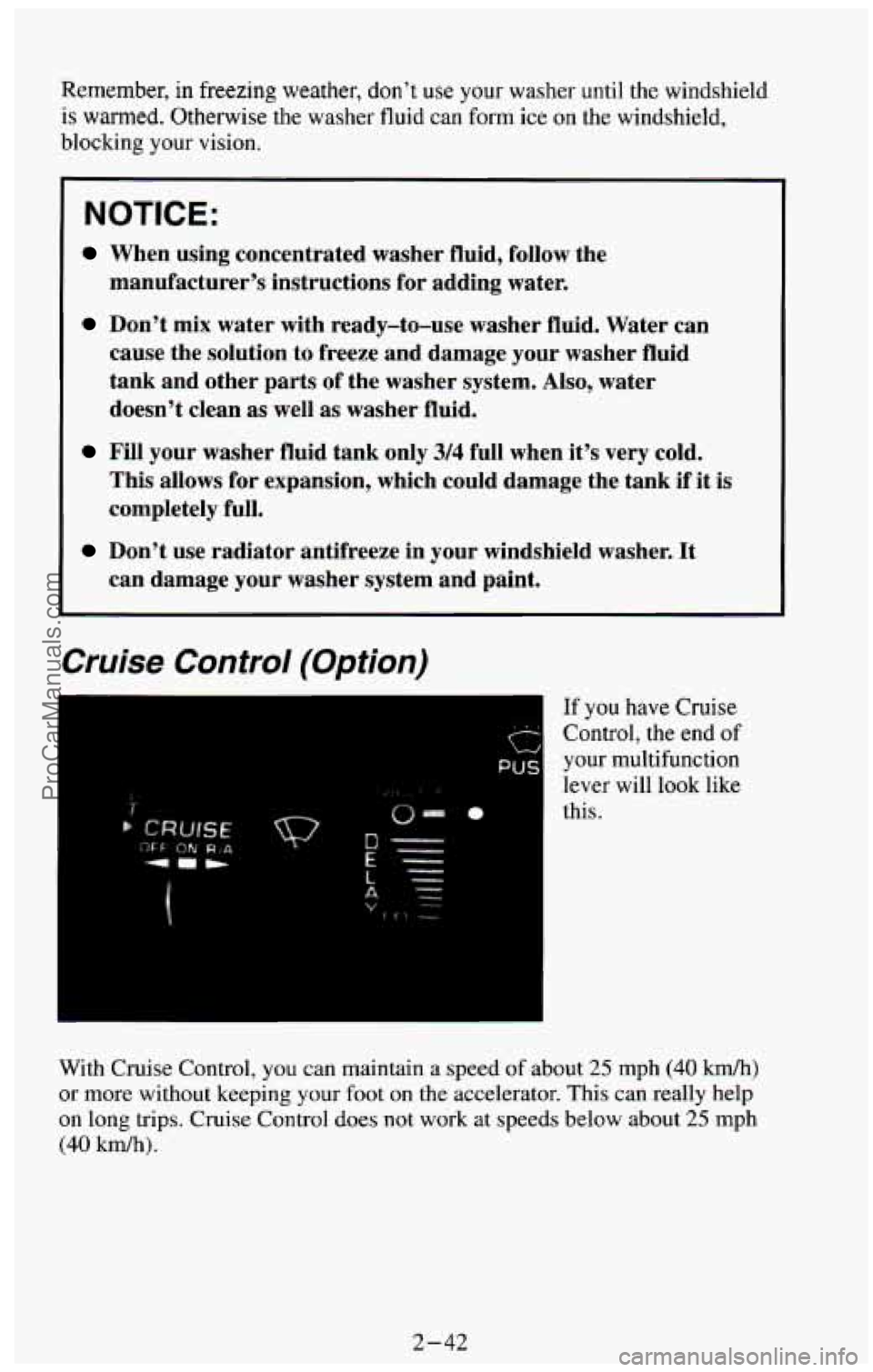
Remember, in freezing weather, don’t use your washer until the windshield
is warmed. Otherwise the washer fluid can form ice on the windshield,
blocking your vision.
NOTICE:
When using concentrated washer fluid, follow the
manufacturer’s instructions for adding water.
Don’t mix water with ready-to-use washer fluid. Water can
cause the solution to freeze and damage your washer fluid
tank and other parts of the washer system. Also, water
doesn’t clean
as well as washer fluid.
Fill your washer fluid tank only 3/4 full when it’s very cold.
This allows for expansion, which could damage the tank if it is
completely full.
Don’t use radiator antifreeze in your windshield washer. It
can damage your washer system and paint.
Gs
PUS
/: . >’
Cruise Control (Option)
If you have Cruise
Control, the end of
your multifunction
lever will look like
this.
With Cruise Control, you can maintain a speed
of about 25 mph (40 km/h)
or more without keeping your foot on the accelerator. This can really help
on long trips. Cruise Control does not work at speeds below about 25 mph
(40 kdh).
2-42
ProCarManuals.com
Page 110 of 385
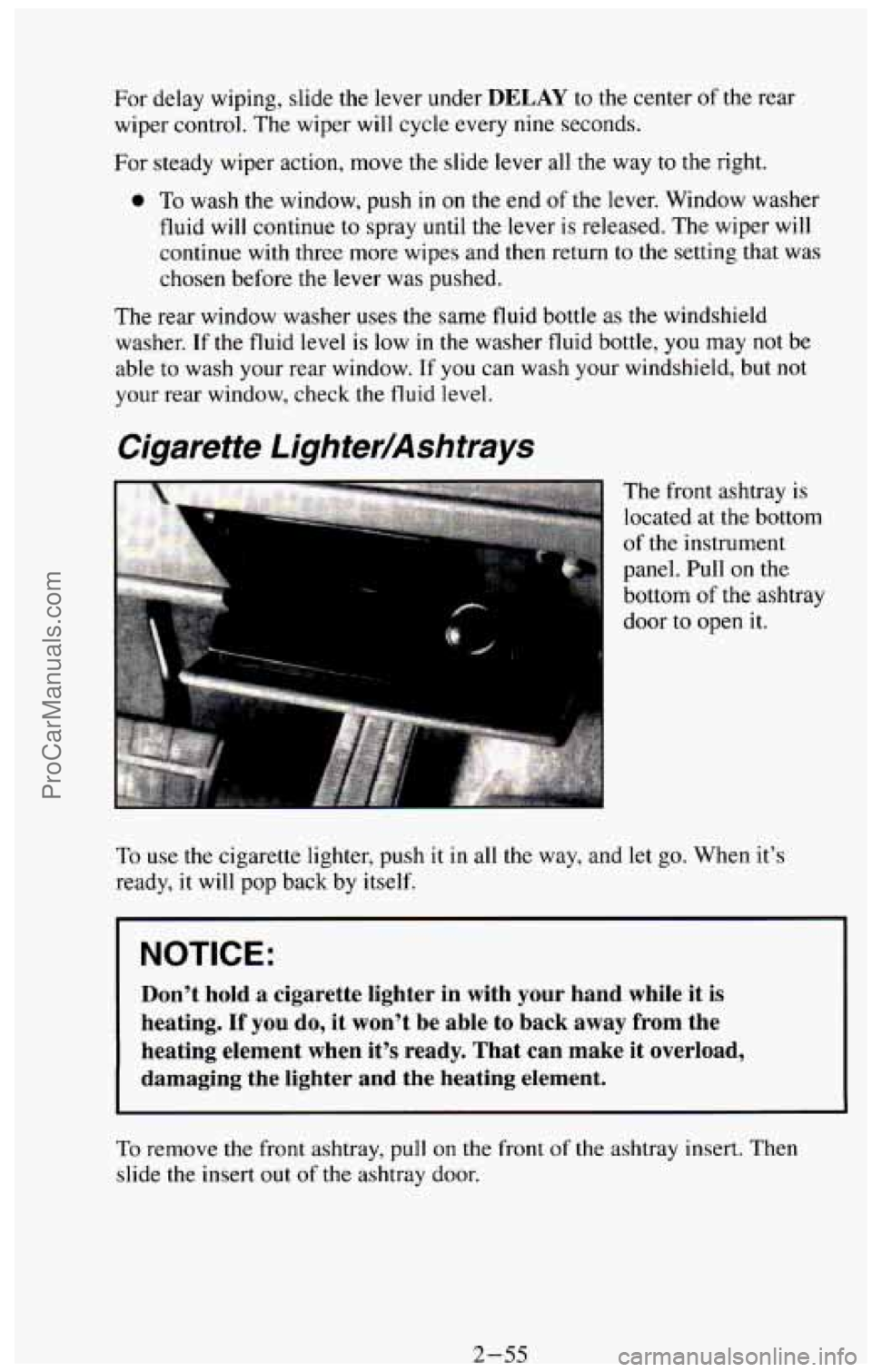
For delay wiping, slide the lever under DELAY to the center of the rear
wiper control. The wiper will cycle every nine seconds.
For steady wiper action, move the slide lever all the way
to the right.
0 To wash the window, push in on the end of the lever. Window washer
fluid will continue
to spray until the lever is released. The wiper will
continue with three more wipes and then return to the setting that was
chosen before the lever was pushed.
The
rear window washer uses the same fluid bottle as the windshield
washer. If the fluid level
is low in the washer fluid bottle, you may not be
able to wash your rear window.
If you can wash your windshield, but not
your rear window, check the fluid level.
Cigarette Lighter/Ashtrays
The front ashtray is
located at the bottom
of the instrument
panel. Pull on the
bottom
of the ashtray
door to open
it.
TO use the cigarette lighter, push it in all the way, and let go. When it’s
ready,
it will pop back by itself.
NOTICE:
Don’t hold a cigarette lighter in with your hand while it is
heating. If you do, it won’t be able to back away from the
~ heating element when it’s ready. That can make it overload,
damaging the lighter and the heating element.
To remove the front ashtray, pull on the front of the ashtray insert. Then
slide the insert out
of the ashtray door.
2-55 ProCarManuals.com
Page 187 of 385
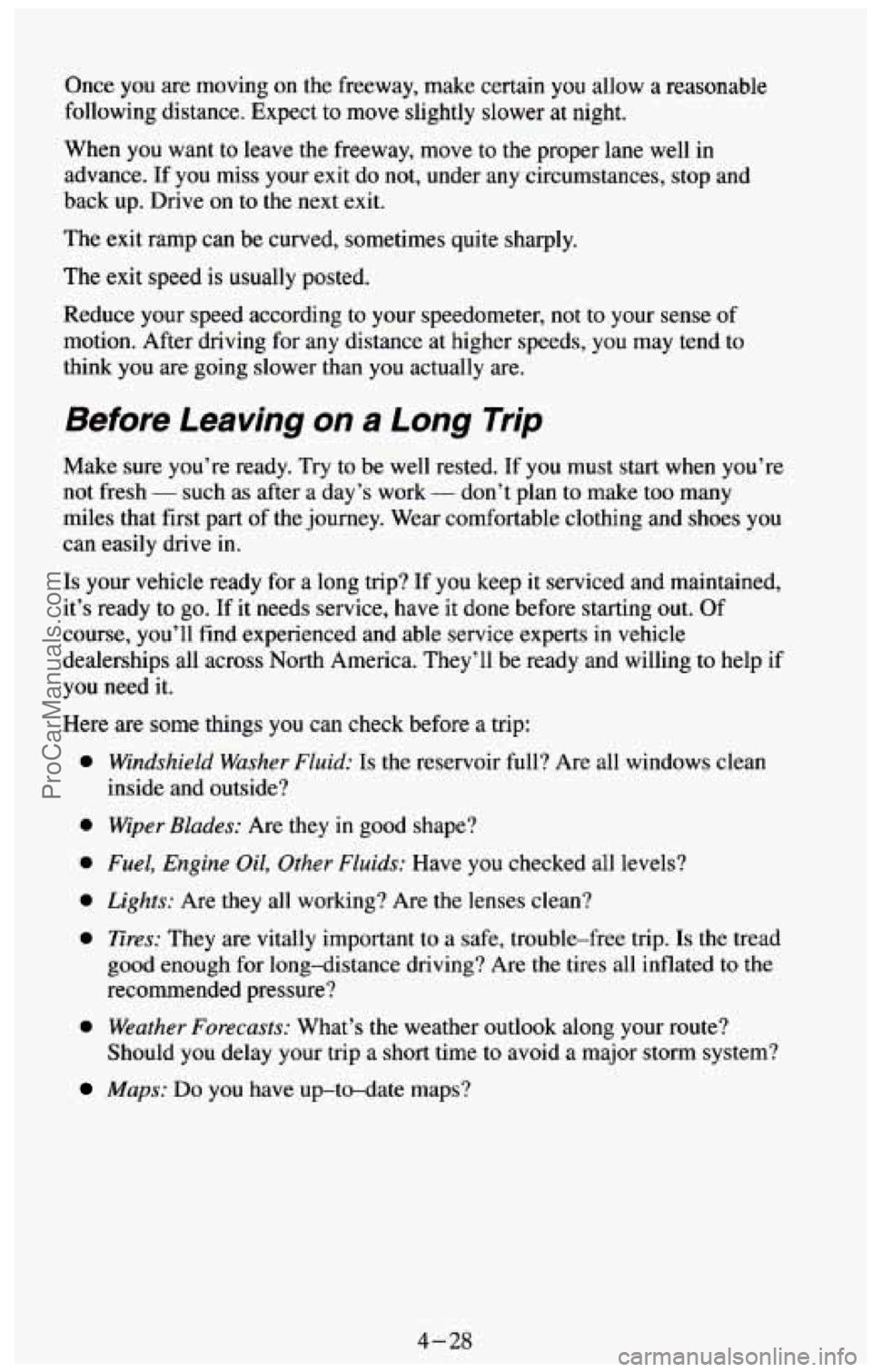
Once you are moving on the freeway, make certain you allow a reasonable
following distance. Expect to move slightly slower
at night.
When you want to leave the freeway, move to the proper lane well
in
advance. If you miss your exit do not, under any circumstances, stop and
back up. Drive on to the next exit.
The exit ramp can be curved, sometimes quite sharply.
The exit speed is usually posted.
Reduce your speed according to your speedometer, not to your sense of
motion. After driving for
any distance at higher speeds, you may tend to
think you
are going slower than you actually are.
Before Leaving on a Long Trip
Make sure you’re ready. Try to be well rested. If you must start when you’re
not fresh
- such as after a day’s work - don’t plan to make too many
miles that first part of the journey. Wear comfortable clothing and shoes you
can easily drive
in.
Is your vehicle ready for a long trip? If you keep it serviced and maintained,
it’s ready
to go. If it needs service, have it done before starting out. Of
course, you’ll find experienced and able service experts in vehicle
dealerships all across North America. They’ll be ready and willing
to help if
you need
it.
Here are some things you can check before a trip:
0
0
0
0
0
0
Windshield Washer Fluid: Is the reservoir full? Are all windows clean
inside and outside?
Wiper Blades: Are they in good shape?
Fuel, Engine OiZ, Other Fluids: Have you checked all levels?
Lights: Are they all working? Are the lenses clean?
Tires: They are vitally important to a safe, trouble-free trip. Is the tread
good enough for long-distance driving? Are the tires all inflated to the
recommended pressure?
Weather Forecasts: What’s the weather outlook along your route?
Should you delay your trip a short time to avoid a major storm system?
Maps: Do you have up-to-date maps?
4-28
ProCarManuals.com
Page 190 of 385
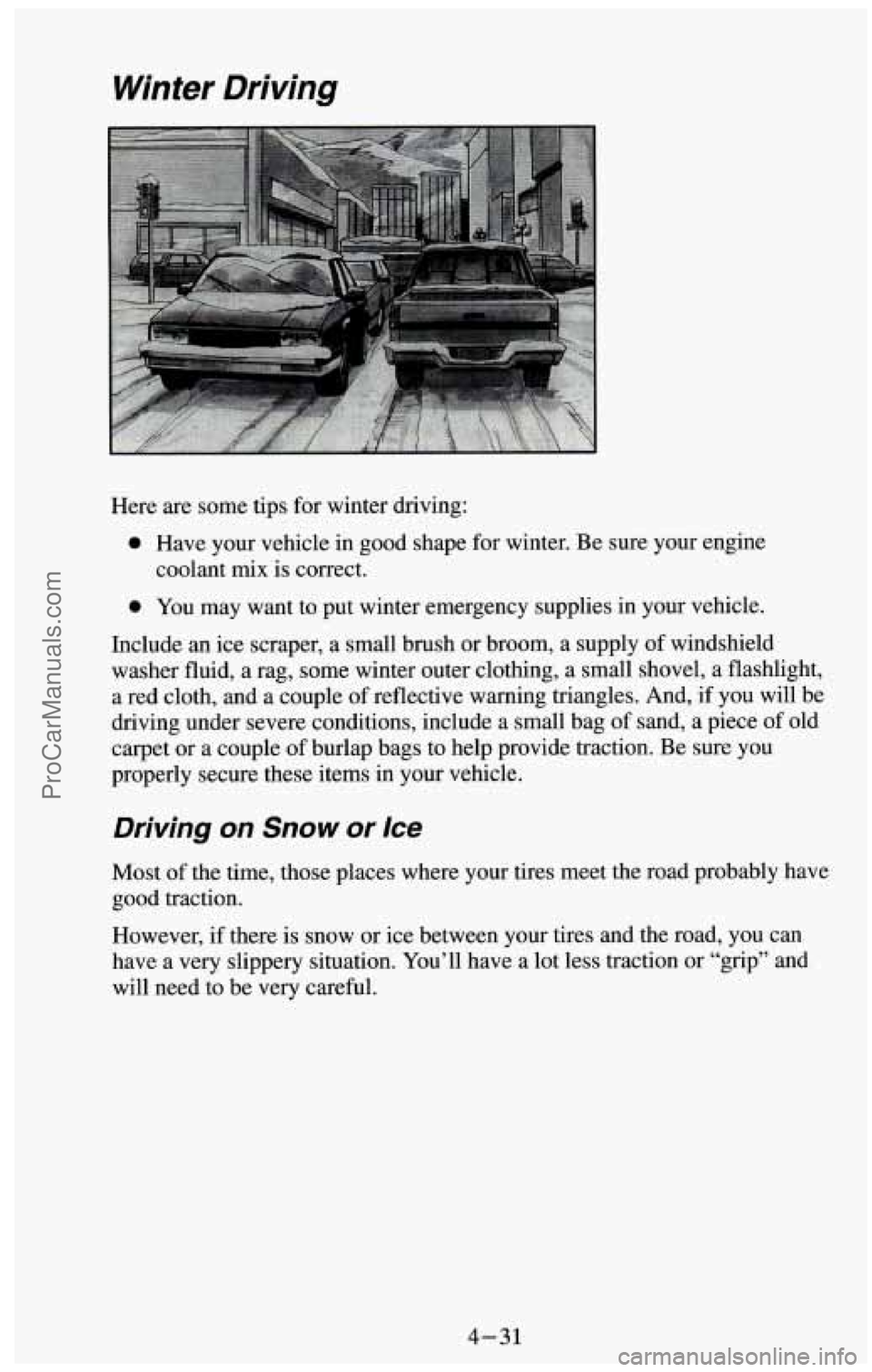
Winter Driving
Here are some tips for winter driving:
0 Have your vehicle in good shape for winter. Be sure your engine
coolant
mix is correct.
0 You may want to put winter emergency supplies in your vehicle.
Include an ice scraper, a small brush or broom, a supply
of windshield
washer fluid, a rag, some winter outer clothing, a small shovel, a flashlight,
a red cloth, and a couple
of reflective warning triangles. And, if you will be
driving under severe conditions, include a small bag of sand, a piece
of old
carpet or a couple of burlap bags to help provide traction. Be sure you
properly secure these items in your vehicle.
Driving on Snow or Ice
Most of the time, those places where your tires meet the road probably have
good traction.
However, if there is snow or ice between your tires and the road, you can
have a very slippery situation. You’ll have a lot less traction or “grip” and
will need
to be very careful.
4-31
ProCarManuals.com
Page 246 of 385
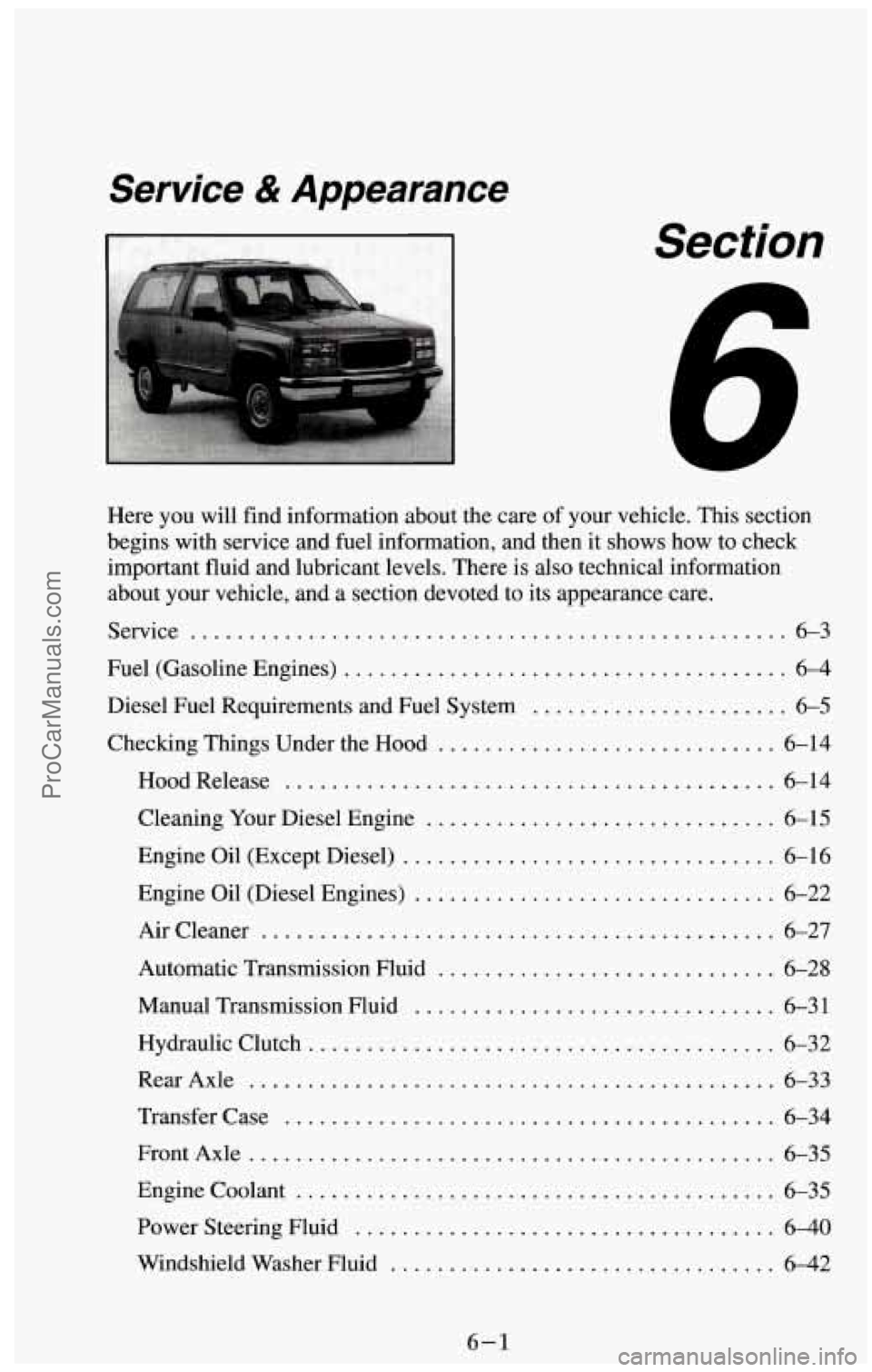
Service & Appearance
I Section
Here you will find information about the care of your vehicle . This section
begins with service and fuel information. and then it shows how to check
important fluid and lubricant levels
. There is also technical information
about your vehicle. and a section devoted to its appearance care
.
Service ................................................... 6-3
Fuel (Gasoline Engines)
............................
Diesel Fuel Requirements and Fuel System ..........
Checking Things Under the Hood ........... .....
........ 6-4
.......... 6-5
......... 6-14
HoodRelease
.......................................... 6-14
Cleaning Your Diesel Engine
............................ 6-15
Engine Oil (Except Diesel)
................................ 6-16
Engine Oil (Diesel Engines)
............................... 6-22
Aircleaner
.................... .................. 6-27 ..
Automatic Transmission Fluid ............................. 6-28
Manual Transmission Fluid
............................... 6-31
Hydraulic Clutch
........................................ 6-32
RearAxle
............................................. 6-33
Transfer Case
.......................................... 6-34
FrontAxle
........................................... 6-35
Engine Coolant
......................................... 6-35
Power Steering Fluid
.............. .................. 640
Windshield Washer Fluid
............................... 6-42
6-1
ProCarManuals.com
Page 287 of 385
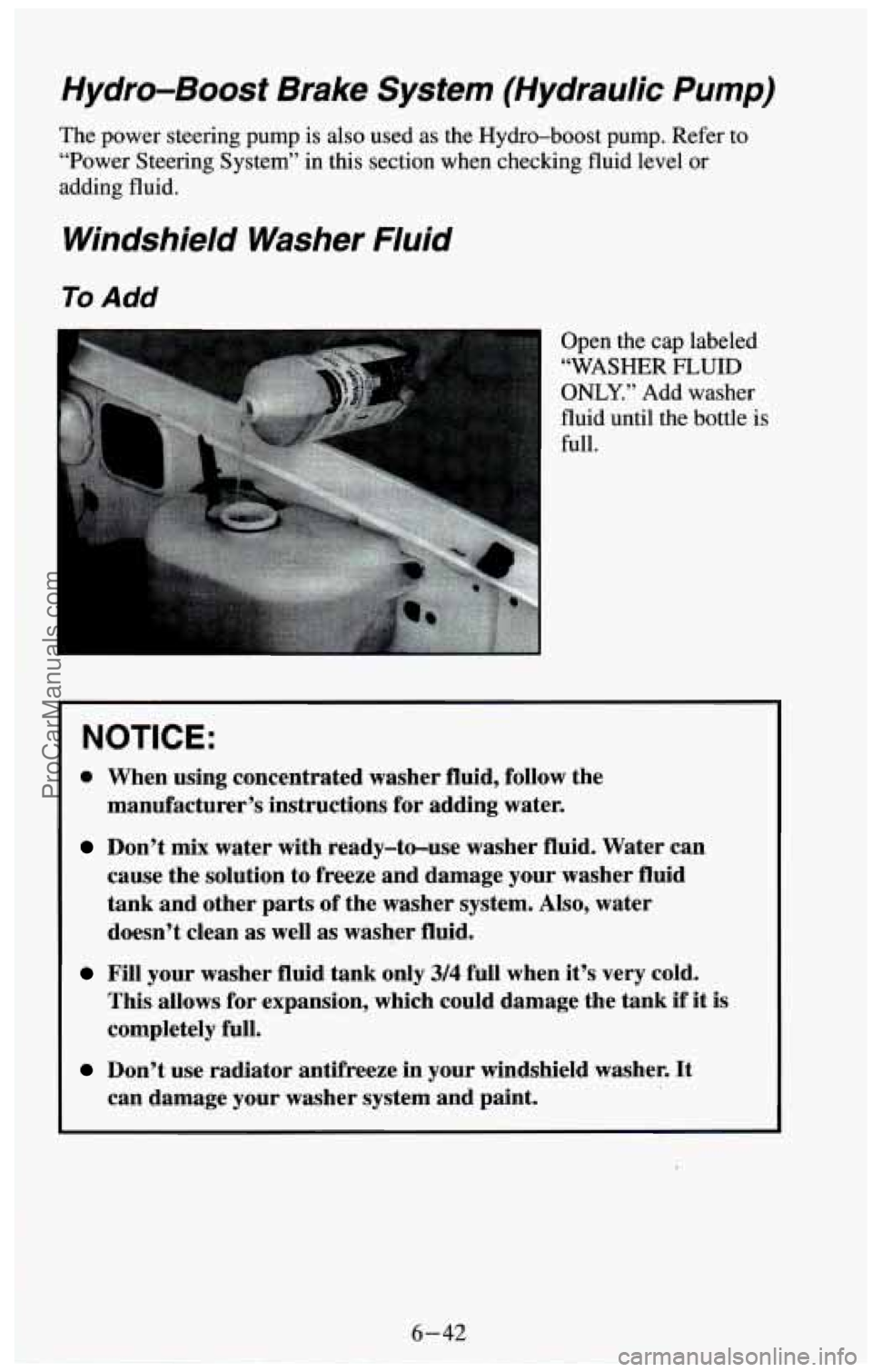
Hydro-Boost Brake System (Hydraulic Pump)
The power steering pump is also used as the Hydro-boost pump. Refer to
“Power Steering System” in this section when checking fluid level
or
adding fluid.
Windshield Washer Fluid
To Add
Open the cap labeled
“WASHER
FLUID
ONLY.” Add washer
fluid until the bottle is
full.
~ NOTICE:
0 When using concentrated washer fluid, follow the
manufacturer’s instructions for adding water.
Don’t mix water with ready-to-use washer fluid. Water can
cause the solution to freeze and damage your washer fluid
tank and other parts of the washer system. Also, water
doesn’t clean as well
as washer fluid.
Fill your washer fluid tank only 3/4 full when it’s very cold.
This allows for expansion, which could damage the tank
if it is
completely full.
Don’t use radiator antifreeze in your windshield washer. It
can damage your washer system and paint.
ProCarManuals.com
Page 360 of 385
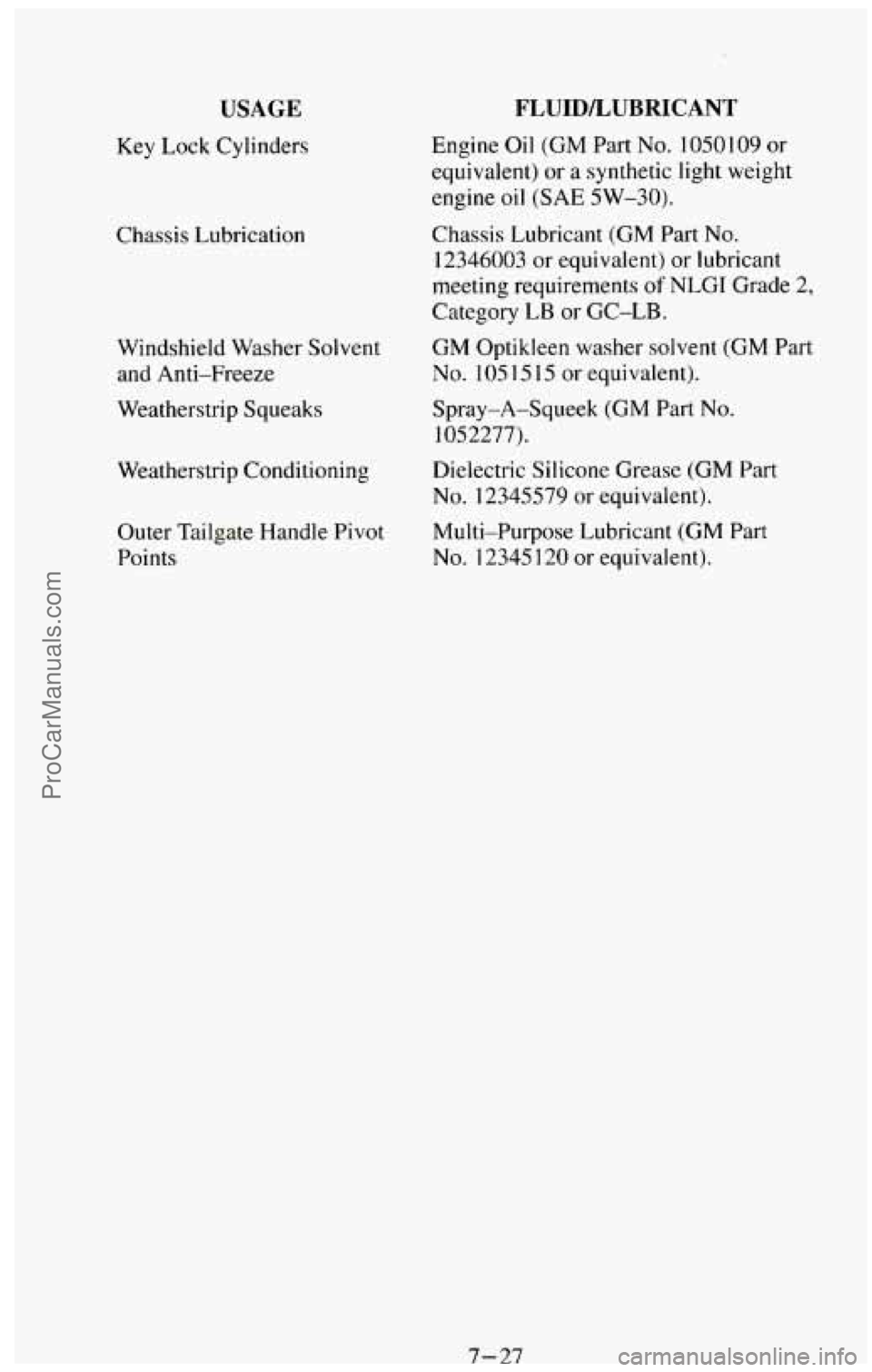
USAGE
Key Lock Cylinders
Chassis Lubrication
Windshield Washer Solvent
and Anti-Freeze
Weatherstrip Squeaks
Weatherstrip Conditioning
Outer Tailgate Handle Pivot
Points
FLUIDLUBRICANT
Engine Oil (GM Part No. 1050109 or
equivalent) or
a synthetic light weight
engine oil
(SAE 5W-30).
Chassis Lubricant
(GM Part No.
I2346003 or equivalent) or lubricant
meeting requirements
of NLGI Grade 2,
Category LB or GC-LB.
GM Optikleen washer solvent
(GM Part
No. 105 I5 15 or equivalent).
Spray-A-Squeek
(GM Part No.
1052277).
Dielectric Silicone Grease (GM Part
No. 12345579 or equivalent).
Multi-Purpose Lubricant
(GM Part
No. 12345 120 or equivalent).
7-27 ProCarManuals.com
Page 362 of 385
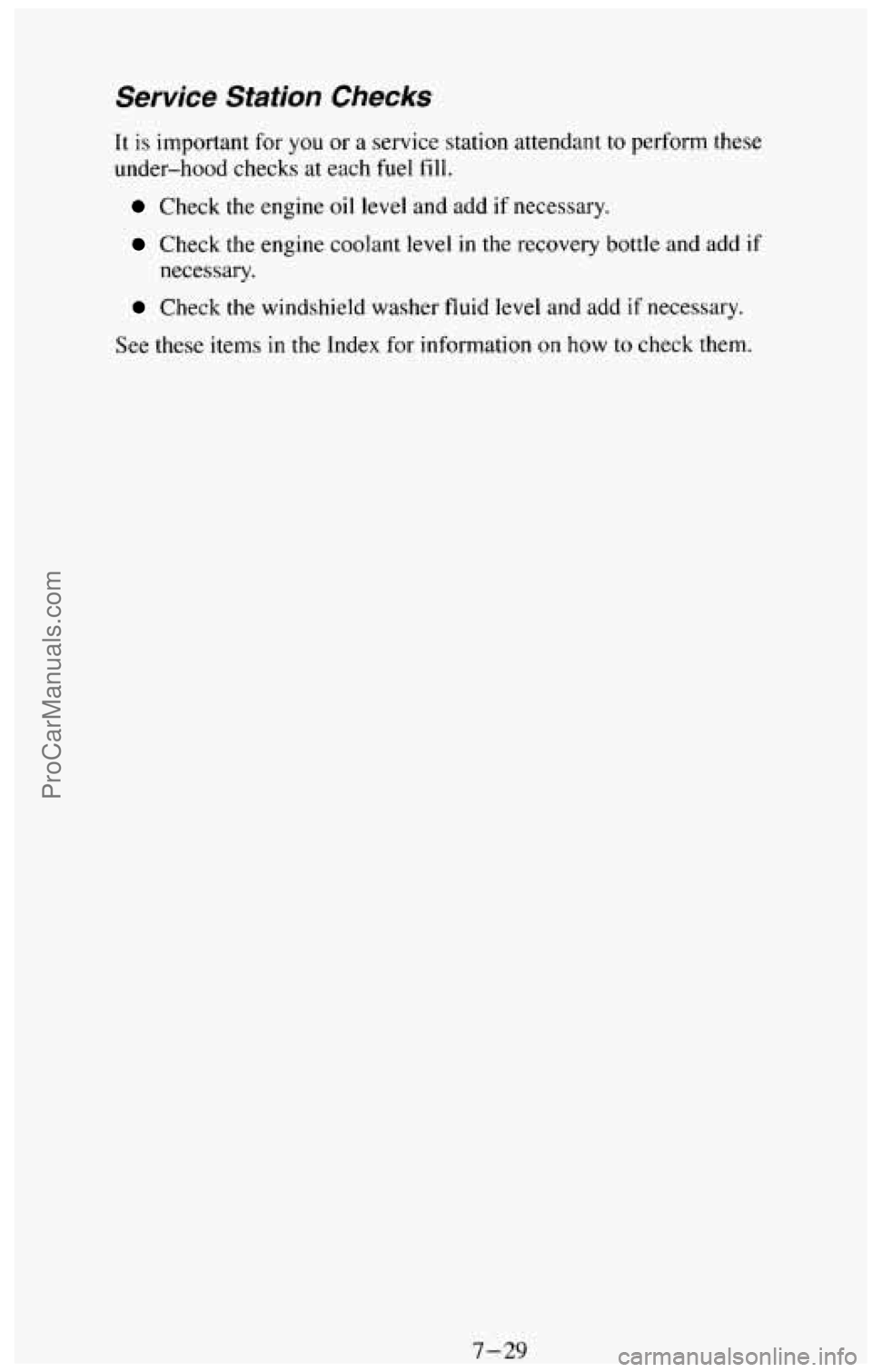
Service Station Checks
It is important for you or a service station attendant to perform these
under-hood checks at each
fuel fill.
Check the engine oil level and add if necessary.
Check the engine coolant level in the recovery bottle and add if
necessary.
Check the windshield washer fluid level and add if necessary.
See these items
in the Index for information on how to check them.
7-29 ProCarManuals.com
Page 378 of 385
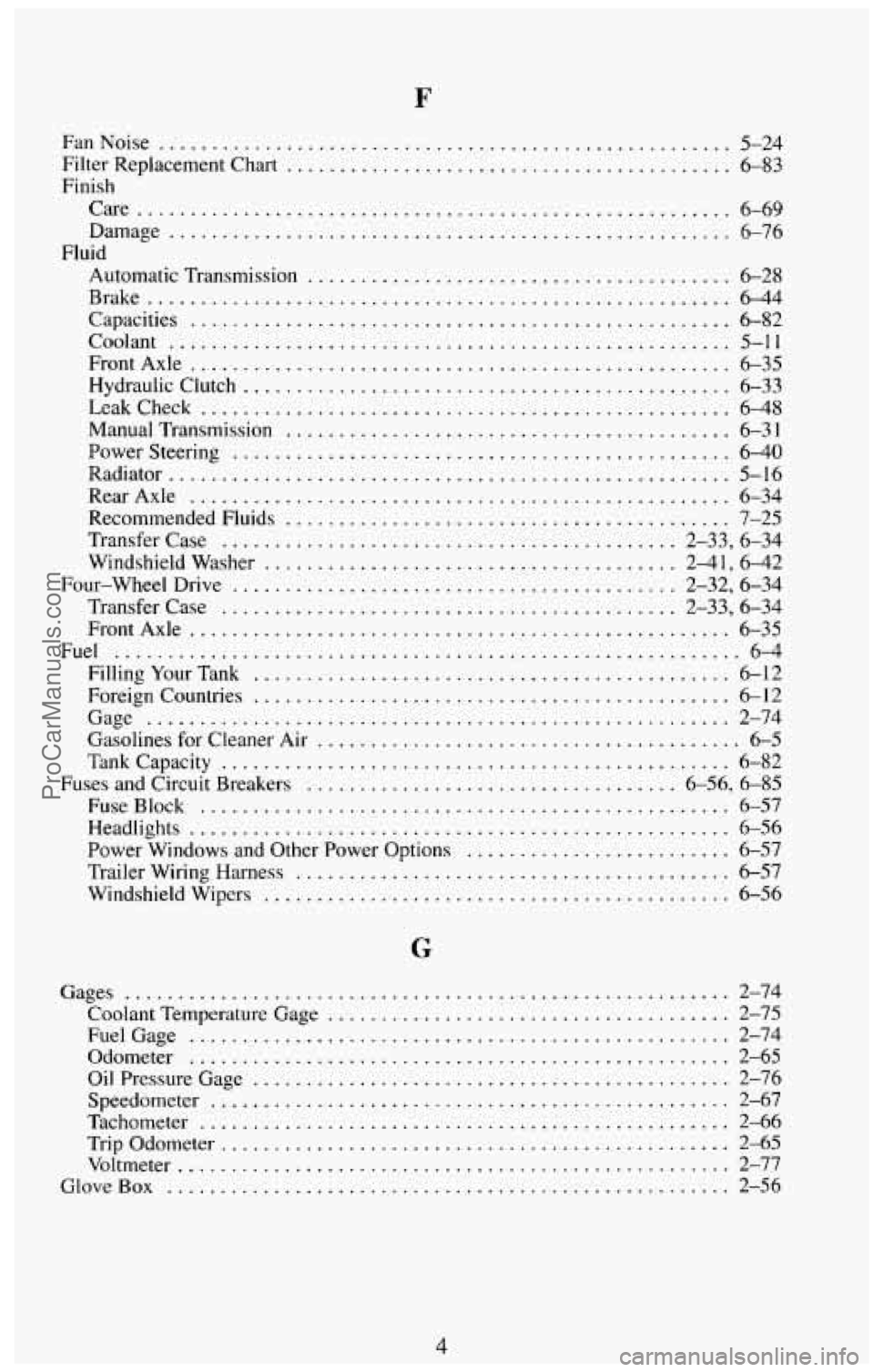
FanNoise ...................................................... 5-24
Filter Replacement Chart .......................................... 6-83
Finish Care
........................................................ 6-69
Damage
..................................................... 6-76
Automatic Transmission
........................................ 6-28
Brake
....................................................... 6-44
Capacities ................................................... 6-82
Coolant
..................................................... 5-11
FrontAxle ................................................... 6-35
Hydraulicclutch
.............................................. 6-33
Leakcheck .................................................. 6-48
ManualTransmission
.......................................... 6-31
Power Steering
............................................... 6-40
Radiator
..................................................... 5-16
Rear Axle ................................................... 6-34
Recommended Fluids
.......................................... 7-25
Transfer Case
........................................... 2-33, 6-34
Windshield Washer
....................................... 2-41, 6-42
Four-wheel Drive
.......................................... 2-32, 6-34
Transfer Case
........................................... 2-33, 6-34
FrontAxle
................................................... 6-35
Fuel
........................................................... 6-4
FillingYourTank ............................................. 6-12
Foreign Countries
............................................. 6-12
Gage
....................................................... 2-74
Gasolines for Cleaner
Air ........................................ 6-5
Tankcapacity
................................................ 6-82
Fuses and Circuit Breakers
................................... 6-56, 6-85
FuseBlock
.................................................. 6-57
Headlights
................................................... 6-56
Power Windows
and Other Power Options ......................... 6-57
Trailer Wiring Harness
......................................... 6-57
Windshield Wipers
............................................ 6-56
Fluid
G
Gages ......................................................... 2-74
Coolant Temperature Gage
...................................... 2-75
FuelGage
................................................... 2-74
Odometer
................................................... 2-65
Oil Pressure Gage ............................................. 2-76
Speedometer
................................................. 2-67
Tachometer
.................................................. 2-66
Trip Odometer
................................................ 2-65
Voltmeter
.................................................... 2-77
GloveBox
..................................................... 2-56
4 ProCarManuals.com